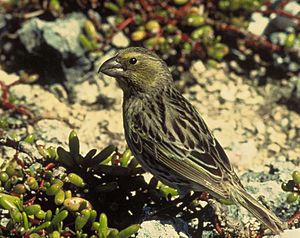Laysan finch facts for kids
Quick facts for kids Laysan finch |
|
|---|---|
 |
|
| Conservation status | |
| Scientific classification | |
| Genus: |
Telespiza
|
| Species: |
cantans
|
The Laysan finch (Telespiza cantans) is a special type of Hawaiian honeycreeper. It lives only on the Northwestern Hawaiian Islands. This bird is one of only four finch-billed Hawaiian honeycreepers left. It is closely related to the smaller Nihoa finch. The Laysan finch gets its name from Laysan Island, where it was first discovered. It was later moved to a few other atolls. In the past, it also lived on some of the main islands.
Contents
About the Laysan Finch
The Laysan finch is a large honeycreeper. It has a strong, thick beak. Male Laysan finches are mostly yellow. They have a white belly and a grey neck. Female finches are not as bright. They have brown stripes on their feathers. It is very easy to spot a Laysan finch. This is because it is the only small bird found on the islands where it lives.
Where They Live and What They Do
Where Laysan Finches Live
When it was first found, the Laysan finch lived only on the small island of Laysan. Other unique birds also lived there, like the Laysan rail and the Laysan duck. Some Laysan finches were moved to other islands. They still live on Pearl and Hermes Atoll. They also lived on Midway Atoll for a while. But they disappeared from Midway after rats were brought there. Old fossils show that Laysan finches once lived on more islands in Hawaiʻi. They even lived as far away as Oʻahu. This means the birds on Laysan are a small group left from a much larger population.
Life Cycle and Diet
Laysan finches build their nests in plants. The female lays three eggs in a cup-shaped nest. She sits on the eggs for about 16 days to keep them warm. The male finch brings food to the female during this time. The baby birds leave the nest after three weeks. Their parents take care of them for another three weeks.
The Laysan finch eats many different things. It eats seeds, small insects, and fruit. It also eats dead animals, like dead seabirds or Hawaiian monk seals. They even eat the eggs of nesting seabirds. They cannot break the eggs of very large seabirds, like albatrosses. But they will eat parts of those eggs if they are already broken. They can easily break and eat the eggs of smaller seabirds. This includes eggs from white terns and the Laysan duck.
Protecting the Laysan Finch
The IUCN says the Laysan finch is a "Vulnerable" species. This means it could be in danger. It lives in a very small area. It is also at risk from bad weather. The State of Hawaiʻi and the U.S. government call it an endangered species.
The Laysan finch survived when domestic rabbits were brought to Laysan. These rabbits caused a lot of damage. They ate almost all the plants. Many other Laysan birds died out because of the rabbits. But the finches survived by eating dead animals and seabird eggs. Laysan Island is now part of the Hawaiian Islands National Wildlife Refuge. The number of Laysan finches is stable now. The biggest danger to them is climate change, which is hard to control.
Gallery
See also
 In Spanish: Palila de Laysan para niños
In Spanish: Palila de Laysan para niños






